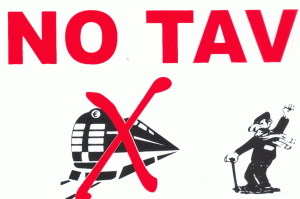The No TAV movement was established 23 years ago in Susa Valley, in the Italian alps west of Turin, in opposition to the proposed New Turin–Lyon high-speed/high-capacity railway project, referred to as TAV (an acronym for high-speed train, treno ad alta velocità).
The No TAV movement seems to exemplify a new wave of social movements that are emerging in the wake of increasing globalization (with its social, economic, environmental and technological repercussions), and have adopted highly democratic, grassroots structures and a “glocalized” vision of the world. It seems a lot like what has been happening with the Occupy movements around the world.
For 23 years, the people of this alpine area east of the French border, have been battling against the project, which has an estimated cost of between 8 and 20 billion Euros depending on the version of the project you look at. The TAV has the support of three levels of Italian Government (national, regional and provincial) and is part of the network of transportation corridors being developed by the European Union.
This is one of the rare moments in Italian politics when all the major political parties – and the current nominated Government under Mario Monti – are in agreement over something: that is the validity and viability of the project as a link to a pan-European vision of transportation networks.
Opposition to the project is rooted in environmental, health, quality of life and economic issues. But the unrest that has been plaguing the area for more than two decades, from large-scale demonstrations and popular occupations to water cannons, tear gas and militarization, may offer hope as a model for the future of the Italian state and perhaps beyond.
Indeed, the local populace appears to have rejected inertia and subservience, and transformed the art of getting by into a sense of empowerment and involvement.
The methods of protest, not just by the people of Susa Valley but also those who support them from Palermo to Venice and from Stuttgart to London, are varied: from theatrical works to hunger strikes, from assemblies and conferences to polenta dinners, and from races around the work site to spells cast by a circle of women at night. There are small contributions full of significance like a young woman who played the violin on an occupied toll highway, and grand gestures like sitting peacefully before dozens of riot police in an act of civil disobedience risking arrest and more.
The movement itself is democratic, grassroots (with no single economic, gender or age-related predominance) and political but with no clear political affiliations.
It is an example of a people well rooted in their territory and traditions that is open toward its nation and Europe creating channels of information, sometimes unconventional, and connections of reciprocal solidarity.
This may be part of the reason for the heavy-handed approach the Italian government has adopted for dealing with the movement. The words “terrorism”, “black bloc” and “anarchist” are often linked to the events in the valley. The controversial designation of the initial work site as an area of strategic importance, thus justifying the presence of hundreds (and sometimes thousands) of military personnel, has also escalated tensions.
The Presidio Europa Committee https://www.presidioeuropa.net is the part of the No TAV Movement which is in contact with other European and international movements and deals with issues linked to the EU. The No TAV Movement is one of the first signatories of theda Charter of Hendaye.

